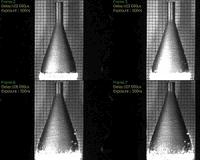| . |  |
. |
Hudson, N.H. (UPI) Dec 21, 2010 The U.S. Navy's mine-hunting sonar system will undergo an upgrade to deal with more sophisticated threats at sea, especially at a time when U.S. forces worldwide face new challenges from both conventional and unconventional foes. Sea mines get less media publicity than land mines, such as those faced to lethal effect by the U.S.-led coalition forces in Afghanistan, but remain a major risk to both battle-ready vessels and auxiliary ships as well as merchant marine traffic. The upgrade will be carried out by BAE Systems as the result of a $14 million contract awarded to the company. BAE Systems said it will deliver an upgraded mine-hunting sonar system to the Navy for the detection and classification of bottom and moored sea mines. BAE Systems will provide four systems under the contract. The AN/SQQ-32(V)4 mine-hunting sonar, set with the high-frequency wide band upgrade, replaces an existing SQQ-32(V)3 detection sonar that is employed aboard the MCM-1 Avenger Class mine countermeasures ships. The upgrade will improve detection performance in the littoral environment and against stealth mines, BAE Systems said. "This is a key win for us and we now have a new customer, a new mission and a new product," said Howie Weinstein, director of Persistent Surveillance for BAE Systems. "We look forward to partnering with the Navy to deliver this improved mine-hunting capability to the fleet." In addition to new detection sonar in the towed body, the upgrade replaces operator consoles in the Combat Information Center. To process the extensive data from new high-speed optical channels within the system, the modernized operator consoles implement a multiple computer server layout interfaced via a 10-gigabyte communications network. With the extensive use of commercial, off-the-shelf open system components within the consoles, the company argued that life-cycle costs for the Navy are reduced. Additionally, it said, the upgrade will incorporate a means for rapid technology insertion. BAE Systems will supply four build-to-print production systems, with two options for an additional 10 systems and one battle spare. The base award value plus these options along with engineering services total $42 million. The AN/SQQ-32(V)4 system was designed by the teaming of the government laboratory Naval Surface Warfare Center, Panama City, and the Applied Research Laboratory, University of Texas. The Lexington Institute think tank in a March 2010 report said, "America's potential adversaries, whether they are peer competitors, rogue regimes or terrorist groups, understand this nation's dependence on open sea lines of communication." It said: "Some prospective adversaries are energetically pursuing the ability to combine the delivery of advanced sea mines with employment of ballistic and cruise anti-shipping missiles and the use of both small boats and submarines to create an anti-access force. The ability of adversaries to interfere with the movement of U.S. forces or global commerce must be judged to be a serious danger." It said the U.S. Navy faced two challenges with respect to addressing the sea mine threat. "One is to modernize the existing mine countermeasures force that will reach the end of its useful life beginning in the next decade. This modernization effort must take place in an environment marked by the growing technical sophistication and proliferation of sea mines. "The other challenge is to both revitalize the U.S. mine warfare capability and provide additional capabilities that can be deployed rapidly to meet new threats," said the institute.
Share This Article With Planet Earth
Related Links The latest in Military Technology for the 21st century at SpaceWar.com
 Ultra Fast Camera Enhances Understanding Of High Explosive Detonation
Ultra Fast Camera Enhances Understanding Of High Explosive DetonationTring, UK (SPX) Dec 22, 2010 Specialised Imaging has released a new application note that describes how its SIM8 ultra fast camera offers the capability to capture and diagnose the process of detonation of high explosive driven liner. The development of short-duration electrical-pulse detonators such as the exploding bridge wire (EBW) allows initiation of secondary explosives to be done with a higher level of safety, ... read more |
|
| The content herein, unless otherwise known to be public domain, are Copyright 1995-2010 - SpaceDaily. AFP and UPI Wire Stories are copyright Agence France-Presse and United Press International. ESA Portal Reports are copyright European Space Agency. All NASA sourced material is public domain. Additional copyrights may apply in whole or part to other bona fide parties. Advertising does not imply endorsement,agreement or approval of any opinions, statements or information provided by SpaceDaily on any Web page published or hosted by SpaceDaily. Privacy Statement |